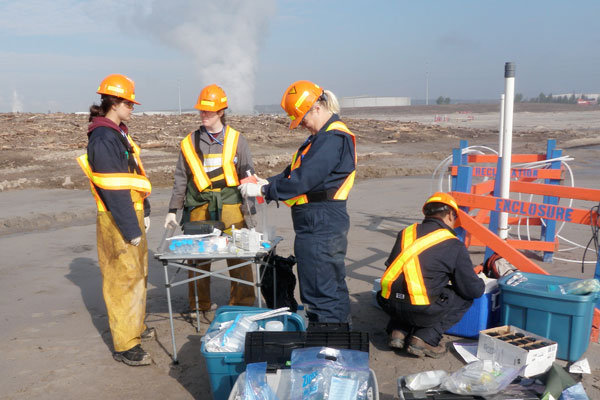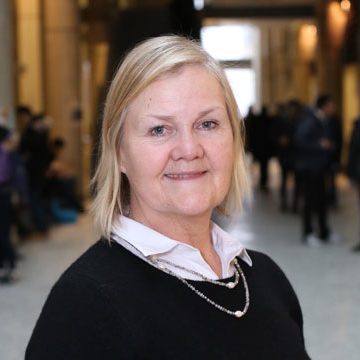This story originally appeared on U of T Engineering News.

Wastewater from a mine doesn’t sound like a cozy habitat, but for untold numbers of microorganisms, it’s home sweet home. A new research project led by Professor Lesley Warren (CivE) will examine how these microbes make their living by studying their genes — an insight that could help further reduce the environmental footprint of the mining industry. The $3.7-million endeavour is funded in part by Genome Canada through the Large Scale Applied Research Projects (LSARP) program.
Extracting valuable metals such as copper, nickel and gold from rocks, which typically contain only a few weight percent metals, requires substantial amounts of water. All wastewater generated must be cleaned to strict federal guidelines before it can be discharged back into the environment. It is these wastewaters that the microorganisms studied by Warren and her team thrive in.
“These wastewaters contain a variety of sulphur compounds that certain bacteria can use for energy,” says Warren, who holds the Claudette Mackay-Lassonde Chair in Mineral Engineering at U of T. “Their ability to do so evolved billions of years ago, long before more complex life arrived on the scene. If the history of Earth were a 24-hour clock, they have been around for over 23 hours, while we humans have been around for only 17 seconds.”
However, our ability to investigate these bacteria and most importantly how they are cycling these sulphur compounds, which will influence the quality of mining wastewaters, has been very limited until now. If these sulphur compounds become too concentrated, the company has to implement costly chemical treatment systems to make the water acceptable for release and avoid toxicity problems in lakes or streams downstream from the mine.

Warren believes that genomics can help. She has spent years travelling mine sites from Canada to South Africa to better understand the sulphur geochemistry of their wastewaters and how bacteria are implicated. “I have always preferred dirty water to clean,” she jokes.
For this project, Warren and her team will apply genomics directly in tandem with comprehensive geochemical analyses and modeling to wastewaters. She will collaborate closely with Professor Jill Banfield, a trailblazer in environmental genomics at the University of California, Berkeley, Professor Christian Baron, a microbial biochemist from the Université de Montréal, and Dr. Simon Apte, a research scientist in analytical chemistry and geochemical modeling from Australia’s Commonwealth Scientific and Industrial Research Organization (CSIRO) Land and Water in Australia, to unravel the role played by these sulphur-loving microbes in important geochemical processes affecting mining wastewaters.
“Mining companies know that microorganisms are driving these reactions, but its still a black box” says Warren. “The lack of available technologies has meant that there has been little research to determine which bacteria are doing what, which ones could serve as early warning signals, or those that could actually be used as the biological treatment itself. Most importantly, mining companies don’t know which levers to pull to control the system.”
Those levers are what Warren and her colleagues aim to identify. Informed by genomic and geochemical insights they plan to develop new tools that can help mine managers make better decisions about how to manage their wastewater. “Once we understand the microbes and how they affect wastewater geochemistry, we can pinpoint the drivers of their behaviour: Which wastewater compounds are they using? Do they like it hot? Do they like it cold? We can adjust those drivers to design new processes that do what we want them to do. Essentially we are mining the bacteria that already exist in these wastewaters as a biotechnology resource.”
With this new knowledge, mines could ensure conditions that encourage the growth of organisms that break down toxic compounds, or prevent the growth of organisms that produce those toxic compounds in the first place. The team is collaborating with three Canadian mining companies, as well as two engineering consulting firms, Advisian and Ecological and Regulatory Solutions. In addition, the Mining Association of Canada, the Ontario Mining Association and CSIRO are further supporting the project.
The project also has the endorsement of the Canadian Institute of Mining, Metallurgy and Petroleum (CIM), the leading not-for-profit technical society of professionals in the Canadian minerals, metals, materials and energy industries. CIM National Executive Director, Jean Vavrek, commented: “CIM are in full support of this exciting new project. While genomics itself is relatively new to the mineral resource industry, it has the potential to provide significant returns and generate new areas for investment in the sector. We consider this a flagship project and will continue to follow Dr. Warren and her team closely as they pioneer genomics research for mine wastewater characterization and possibly treatment.”
“The mining industry has driven this project from its inception because they want to reduce their environmental footprint. Harnessing the biological potential of their wastewaters will facilitate the development of such strategies to achieve this goal,” says Warren. “So many of the organisms we’re finding are new to science. The chances that we are going to find organisms that are capable of doing creative things that could be useful are very high.”